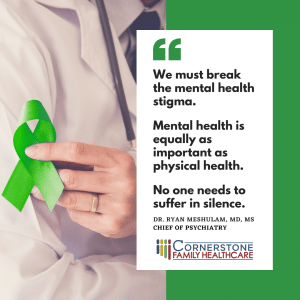Blog by Robert Hixon, BSN,RN, AEC, Lead Nurse Primary & Preventative Care
The coming of winter in the northeast is evidenced by gray skies, falling temperatures and a chilling wind. These changes often encourage us to retreat back into the warmth and safety of our homes. However, this winter, much like this entire past year, has been quite different. Across the globe, all human beings have been touched by the same unyielding reality. This reality caused many of us to seek shelter, long before the onset of cold weather, to wear masks on our face before harsh winds came in, and to cause fear of the unknown.
COVID-19 (also known as the coronavirus) is certainly a name that is known by everyone at this point. As a nurse, my colleagues and I have swabbed more than 7,500 people over the last several months, collecting specimens that are then tested for COVID-19. More than testing, we have listened to our patients’ stories. So many families just in our local community have been effected by this virus in devastating ways—ways that have literally reshaped their families. I want to remind this community and others, the resilience you have shown under the incomprehensible situations many of you faced is nothing short of inspiring. Your ability to push on and keep moving forward through illness and uncertainty is a testament to our community’s indomitable spirit.
When speaking with these families, one theme emerged as more prevalent than any other. The word that best describes this sentiment is helplessness—the sense that beyond wearing masks and isolating, what can we do to fight back? This new virus seems to have confounded many of our brightest minds, creating more questions than answers. While specialized medical teams comprised of virologists, epidemiologists, immunologists, and the like diligently work towards an end to this pandemic, what do we, as individuals, do? Many medical experts speculate an effective vaccine against COVID-19 may come around the end of spring 2021. That means it could be well into the summer before we may start to return to something that resembles a pre-COVID world, if ever.
I have thought and reflected on the feelings of my community and of my own family. As many nurses and medical staff can attest, the concerns of our patients often resonate with us, long after our encounter in the office. This idea that we are helpless and we have no proactive way to respond to our current situation is not accurate. Among the few things we know for sure about COVID-19 is that those with chronic illness or a weakened immune system have significantly increased risk of poor outcomes if they become infected. Some of these risk factors can and should be addressed in order to greatly reduce the risk of a severe illness and poor health outcomes.
Through various processes, COVID-19 is able to attack our lungs, often resulting in a type of pneumonia. This pneumonia impairs gas exchange, which is our bodies’ primary mode of expelling waste (carbon dioxide) and delivering energy (via oxygen). This process, cellular respiration, is imperative for normal body function as well as healing. Viruses, such as COVID-19, can increase our natural inflammatory process, causing excessive immune response. While COVID-19 presents risks to healthy individuals, the body’s responses to the virus are amplified by certain comorbidities.
Some of the most severe COVID-sensitive comorbidities—which also happen to be among the most prevalent in the communities Cornerstone serves—include COPD, heart conditions, type 2 diabetes mellitus, and asthma, as well as being over the age of 65. The good news is community health centers such as Cornerstone are in an ideal position to address these comorbidities. Reducing these risk factors through routine care and vaccination can significantly lower your susceptibility to poor outcomes, should you contract COVID-19.
We have adopted a method which mitigates risk while addressing the needs of our communities during these turbulent times. This proactive approach addresses reducing risk of contracting the virus, as well as promoting best outcomes for those who do. The CDC, WHO and our local Department of Health, among others, all emphasize the importance of managing chronic health conditions and routine vaccinations to maintain overall health and help avoid the risk of major complications if you are exposed to COVID-19. With our communities in mind, let’s review some vaccines that may be most beneficial:
Pneumococcal Vaccines
Based on public health data for our area, it is likely that many who are reading this article live with conditions such as asthma, liver or lung disease, and/or diabetes. If you smoke cigarettes or are just older than 65, you might want to inquire about pneumococcal vaccines. There are currently two pneumococcal vaccines (PCV 13) and (PPSV23). If indicated, these vaccines can drastically reduce your risk of pneumonia, ear infections, sinus infections, and even some types of meningitis.
Shingles and Seasonal Influenza Vaccines
If you believe you have had chicken pox and/or you live in this region during flu season, you may want to review the benefits of both the shingles and seasonal influenza vaccines. Those who have had chicken pox, if it was decades ago, might not realize they are presently living with a shingles virus. That virus can come to the surface as a painful rash, brought on by stress, illness or another variable. This virus can leave you with pain and burning in your nerves known as post-herpetic neuropathy.
Finally, we are entering influenza season. While some may liken the flu to a common cold, those inflicted know this is not the case. The flu hospitalizes hundreds of thousands during a modest influenza season. These numbers are expected to be dwarfed if flu and COVID-19 surge simultaneously.
In conjunction with immunizations, ensuring certain health conditions are well managed is a central tenet of our plan for community health and well-being. Tight control of diabetes, hypertension, asthma and others are critical to our patients’ safety. This can be accomplished by ensuring medications supplies are available for a minimum of 30 days. Patients should understand symptoms and changes in their condition and have a plan of action if this occurs. Asthmatics should have an asthma action plan and understand how and when to administer their medications. Finally, patients and providers should explore their comfort levels and needs and decide what is required to achieve patients’ health goals.
It can be easy at times to become transfixed on those things which loom so large. They can take over your thoughts and make it difficult to focus on what is in front of you. For many of us, COVID-19 has become one of those things. Reflecting on those 7,500 patients and of our shared experiences over the last several months leaves me with a distinct feeling. However, it isn’t one of sadness or helplessness. It is pride in the values that our community has exhibited—spirit, strength, appreciate and optimism—that has stayed with me. It is our hope that these same qualities are reflected in the care you receive from Cornerstone Family Healthcare.




